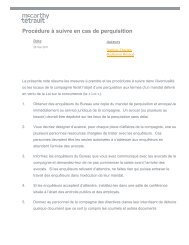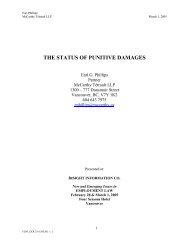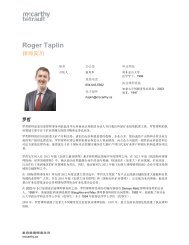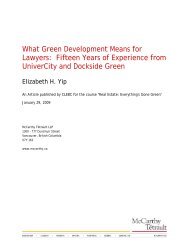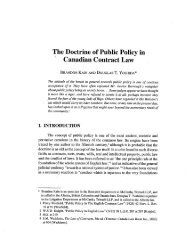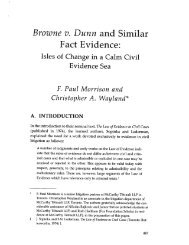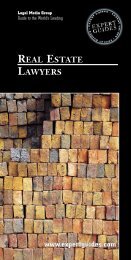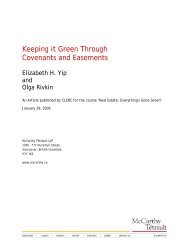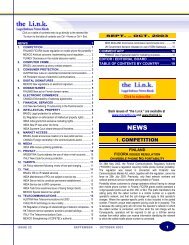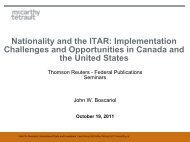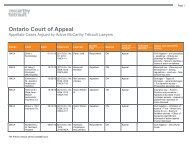Presentation Material - McCarthy Tétrault
Presentation Material - McCarthy Tétrault
Presentation Material - McCarthy Tétrault
Create successful ePaper yourself
Turn your PDF publications into a flip-book with our unique Google optimized e-Paper software.
Chris Falk<br />
Stefanie Morand<br />
<strong>McCarthy</strong> Tétrault LLP<br />
In response to the Crown’s first argument, Mr. Justice Hershfield concluded that the express<br />
language of subsection 84(2) “ensures that it is only a shareholder at the time of the distribution<br />
or appropriation who can be deemed to be the recipient of the dividend”. 45<br />
In the case at bar, the property that the taxpayer received at the beginning of the series of<br />
transactions was the Brother Note, which was not property of Canco. When amounts were<br />
subsequently paid by Canco to the taxpayer, the taxpayer was no longer a shareholder of<br />
Canco and the taxpayer received the amounts qua creditor. Further, Canco’s property was<br />
distributed by way of dividend to Holdco. Mr. Justice Hershfield held that the phrase “in any<br />
manner whatever” relied on by the Crown does not have the effect of “redirecting” to whom<br />
dividends are paid; rather, “[i]t is the manner of effecting the distribution to the shareholder at<br />
the time of that distribution that the subject provision is aimed”. 46 Accordingly, it was not<br />
relevant that the Brother Note was repaid using Canco funds.<br />
As for the Crown’s reliance on RMM where Mr. Justice Bowman, as he then was, concluded<br />
that subsection 84(2) applied, Mr. Justice Hershfield acknowledged that the facts in RMM were<br />
not easily distinguished from the case at bar. However, he noted that the decision in RMM<br />
stands in contrast to Mr. Justice Bonner’s decision in McNichol where the facts were also similar<br />
to those in issue. While Mr. Justice Bowman sought to distinguish McNichol in RMM, Mr.<br />
Justice Hershfield rejected the distinction and concluded that “the McNichol approach which<br />
was to look to section 245 when subsection 84(2) does not apply on a strict construction of its<br />
language, is the correct approach”. 47<br />
In respect of the Crown’s third argument, Mr. Justice Hershfield concluded that a “purposive<br />
contextual analysis” of subsection 84(2) did not support a less literal interpretation of the<br />
provision. He stated (at paragraphs 66 and 67):<br />
In my view, there is nothing in the language of subsection 84(2) that warrants a finding of a<br />
rationale other than liquidating distributions out of a corporation’s earnings to its shareholders –<br />
holding a particular class of shares – are to be treated as dividends to the extent the distribution<br />
exceeds the paid-up capital of the particular class of shares held by persons receiving the<br />
distribution. […]<br />
[…] The surplus strip here was having the Appellant’s shares acquired with corporate funds<br />
funnelled through a related corporation as a tax-free dividend. This classic strip in the old<br />
system was subject to a specific anti-avoidance provision; namely section 138A of the old, pre-<br />
1972 Act. That provision was replaced in 1972 with section 247 which was repealed in 1988.<br />
The section that survived is, of course, section 245. That is the provision to look at in these<br />
circumstances. Essentially that is what Justice Bonner concluded in McNichol and I agree.<br />
(italics original)<br />
And later (at paragraph 82):<br />
In the circumstances of this case, there is nothing in subsection 84(2) of the Act that invites the<br />
CRA or this Court to change either who the recipient of the benefit is, or the legal status or<br />
capacity of the recipient. To re-characterize or ignore the Appellant’s legal status in this case<br />
invites consideration of the application of section 245 of the Act. Subsection 245(5) allows just<br />
45<br />
46<br />
47<br />
Ibid., at para. 50 (emphasis added).<br />
Ibid., at para. 48 (emphasis added).<br />
Ibid., at para. 59.<br />
560600/422632<br />
MT DOCS 11864055v1G<br />
15



